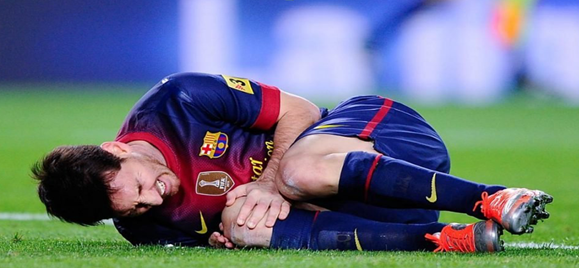An Overview of Knee Meniscus Tear and the Rehabilitation Early Phase of Management with Physical Therapy Based on Studies Research
Meniscus injuries can cause discomfort, pain, and anxiety for patients, who may worry about their ability to return to their previous lifestyle. However, physical therapy in Manchester City Centre offers an effective solution for healing and managing knee injuries. Through personalized treatment plans, physical therapy can enhance knee function, reduce pain, and promote recovery. This article provides valuable insight into the benefits of physical therapy for meniscus tears.
The knee is one of the joints that is most injured due, in part, to the fact that it supports body weight and also due to its own biomechanical characteristics, the menisci being a very important part of the knee as they are in charge of providing joint congruence to this joint. In the case of a meniscus tear, the physiotherapeutic approach with physical therapy and sports massages in Manchester, will be essential to return to activities of daily living and sporting practices, too. Generally, the medical approach for a torn meniscus consists of an arthroscopic partial menisectomy, after which the patient will often present with knee swelling, pain, loss of joint range of motion (ROM), extensor muscle deficit, etc. It is paramount to highlight that elite athletes are extremely prone to suffer from knee injuries compared to general population, especially in those activities where pivoting and contacts are implied (Riccardo D’Ambrosi et la, 2022).
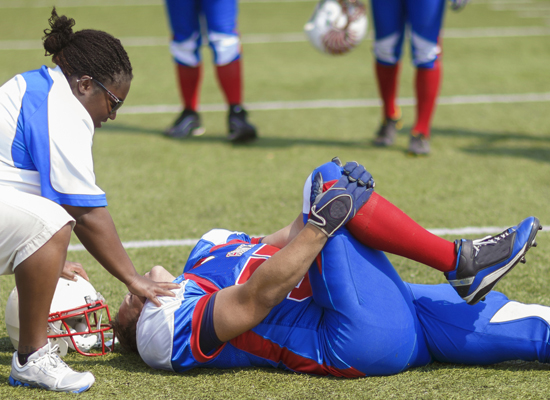
Athletes are greatly vulnerable to this condition, since a lot of sports may require both twisting and compression making use of the knees. Aging is a risk factor as well. Nevertheless, individuals of all ages and practitioners of any activity can get their knee injured. A meniscus tear is one of the most frequent injuries in the knee joint we treat at our Sports Injury Clinic in Manchester and can be caused by various causes. It is estimated that 50% of meniscus and ligament injuries occur in athletes (with an incidence of 1/1000 for menisci), and at the same time, that 30% of all sports injuries correspond to meniscal injuries. This condition has a prevalence rate around 12% to 14%. In addition, meniscus injury has an incidence of 65 cases per 100,000 inhabitants per year, appearing more frequently in males (Enkhmaa Luvsannyam et la, 2022).
The menisci are fibrocartilages found in the knee joint, between the femur and the tibia. There are two menisci in each knee. They are responsible for improving joint congruence, that is, favoring the fit between the femur and tibia, and distributing the forces that this joint supports. In addition, they favor the knee to be more stable, facilitate movement and participate in the stability of the joint.
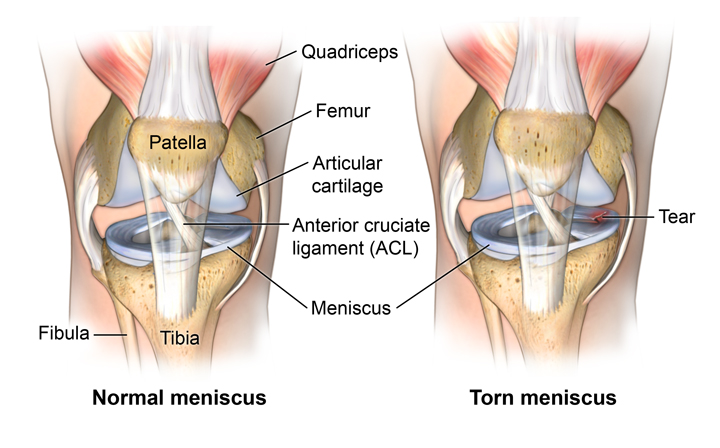
What Function Does the Meniscus Have?
Its main function is to allow the transmission of stress between the femur and tibia, as well as being the stabilizers of the knee and those that distribute the synovial fluid inside it. Thus, they are two elements that support and resist a large compression load (Alice J. S. Fox et la, 2012).
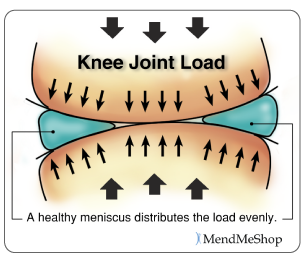
How Does a Meniscus Injury Occur? And Which People Are More Exposed to Suffering From it?
We speak of a meniscus injury when there has been a tear, rupture or displacement of said cartilage, which usually happens more internally than externally. It is a frequent injury and occurs more in men than in women (B E Baker et la, 1985).
The Meniscus Can Be Injured at Any Age and For Various Reasons
Due to trauma from movements that involve a sudden twist of the knee (such as sudden pivoting or sudden braking and turning). These gestures are associated with sports practice in young people. For example, when playing soccer, basketball, or tennis, there are sudden changes in speed or you put your weight on one foot and then forcefully rotate your knee.
Those movements in which there is a sudden hyperflexion or hyperextension of the knee, kneeling, lifting or squatting or lifting something heavy, can also damage it. In people of a certain age, the degenerative phenomena suffered by the cartilage may be the cause of its breaking with these minimal traumas or even without trauma. And it is that age is one of the factors that increases the risk of meniscus tear, due to wear.
Some alterations or deformities that certain people present in the anatomical arrangement of the knees (varus or valgus knees, for example) make them more prone to wear of the menisci due to overloading them.
What Symptoms Does Knee Meniscus Injury Cause?
When the meniscus injury occurs, the joint hurts with variable intensity depending on aspects such as the size, type of tear, or the mechanism that caused it (if it is a trauma, the pain usually has a more acute character than what happens when the meniscus is injured). meniscus wears progressively until it breaks). The pain can be located at different points, although, in general, it is located in the injured meniscus at the specific moment in which the tear occurs.
Also, the knee swells or inflames (it can even bruise) and becomes stiff. On occasions, it can be totally or partially blocked (it is the sensation of having the knee locked when you try to move it) or notice difficulty in fully extending it. Meniscus crunches can also appear, although if they are not accompanied by pain, that is, they are isolated, they should not alarm us.
At My Sports Injury Clinic we help you take care of your health to prevent this type of injury and maintain your quality of life. If you have any type of ailment related to the meniscus, do not hesitate to request an appointment with our experts in physical therapy and manual therapy in Manchester and we will help you solve it, click the following link to book an appointment https://mysportinjury.janeapp.co.uk/
What Complications Does This Knee Injury Entail and How is The Knee Meniscus Injury Treated? Can Physical Therapy Help Knee Injuries?
Over time, a meniscus tear can become complicated and make the affected knee unstable or limit its movement. Likewise, it can cause chronic pain and the chances of suffering osteoarthritis in the joint in the future increase. Therefore, it is necessary to choose and start the most appropriate treatment as soon as possible, which will depend on the type, size and location of the lesion, as well as the patient's age and activity level.
Initially, the doctor and physio in Manchester must assess and indicate the most appropriate course of action.
Non-steroidal anti-inflammatory drugs may be added to relieve pain and reduce swelling. A physiotherapy program in Sports Injury Clinic is also necessary, which will include exercises to increase the flexibility and strength of the knee and the muscles around it, which will increase its stability.
The treatment plan for a Knee Meniscus Tear involves tailored physiotherapy sessions that encompass various approaches. Manual therapy in Manchester is employed to alleviate pain, drainage techniques help remove inflammatory fluid, joint techniques enhance mobility, and exercises aim to bolster muscle strength. Rehabilitation exercises target muscle strength and proprioceptive exercises enhance balance and body awareness. Additionally, balance exercises and gait reeducation are incorporated to optimize the overall treatment process. This comprehensive approach ensures effective recovery and improved knee function.
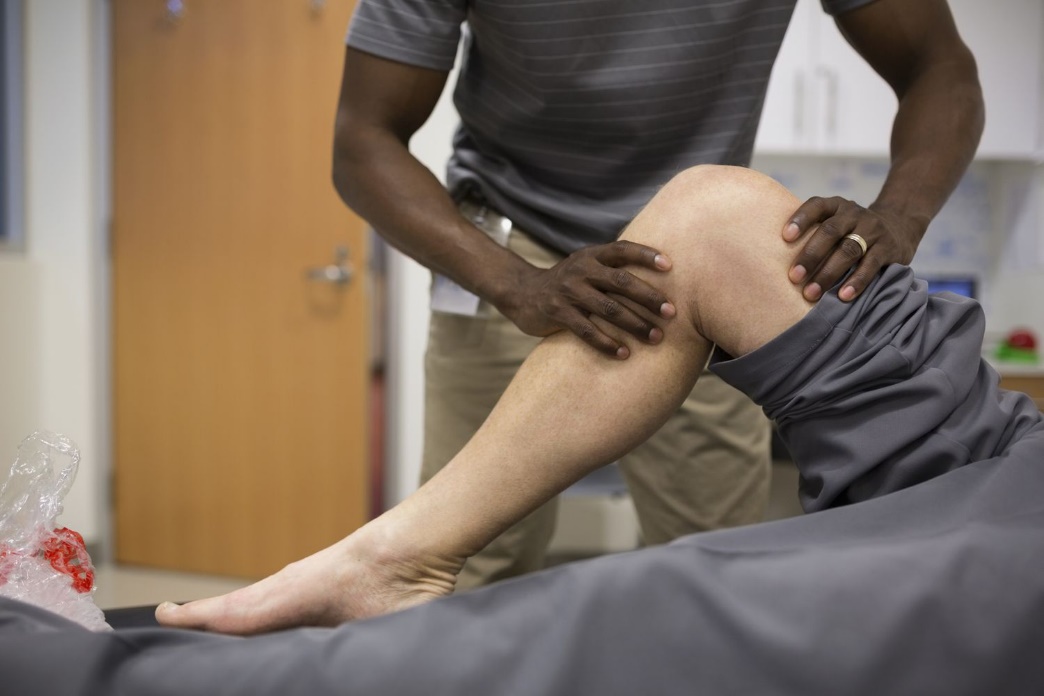
In addition, a series of conservative measures must be taken consisting of the following.
- Rest: rest, try not to walk and avoid sports or any activity in which you lean on the knee, turn it or flex it, for the period of time that your doctor advises.
- Ice: in order to reduce inflammation and reduce pain, apply cold to the affected area for forty-eight hours after the injury.
- Compression: depending on the degree of severity of the injury, a bandage, a knee pad or a splint can be placed.
- Elevation: when you are sitting or lying down, keep the affected extremity elevated.
If Surgery for Torn Meniscus is Needed, How Long Will the Recovery Time Frame Be?
It is pointed out that elite athletes are likely to return to sports activities from 4 up to 6 months after undergoing surgical intervention, according to (Tammam Hanna et la, 2022).
What is the Expected Time Frame to Recover from a Torn Meniscus Dealt with Physical Therapy in Manchester?
Regularly this rehab process of Torn Meniscus Injury treated with Physical Therapy will range from 6 up to 8 weeks. It should be noted that this will only be able to come about with the guidance of a top-notch physical therapy rehab and a suitable reduction of sporting activities. Conservative management / Physical Therapy is the best treatment option for meniscus injuries but when the symptoms of locking, giving way, or significant instability, are not presented, (according to HealthLine).
How Can I Avoid Meniscus Injuries?
The vast majority of meniscus injuries are very difficult to predict, since they occur when the knee is turned suddenly on a stationary foot.
The recommendations to prevent this type of injury include limiting just a bit, physical activity and demanding training, but also carrying out exercises that increase muscle mass in that area so this area will be the one which absorbs the greatest impact of the exercise, so by doing this way, the weight does not affect that much the menisci.
5 Tips to Prevent Meniscus Injuries and Knee Problems
Although in the previous paragraph we have already indicated some keys to prevent this type of annoying injury/ knee problems, we now detail a series of tips that will help you avoid these ailments.
- Exercise regularly
But avoid aggressive knee poses like deep squats and heavy weights. To avoid this type of injury, it is advisable to strengthen the leg muscles that help stabilize and protect the knee.
- Don't forget about warming up and stretching
Training is important, but it is also important to warm up your body beforehand and stretch it after physical work, especially if the legs are involved.

- Wear the right footwear
When you do sports you should wear the right shoes, especially with good foot support and good heel support. Likewise, it is key that you learn and use the appropriate techniques for the sport you practice, so you will always avoid injuries of all kinds.
- Take care of your back
An imbalance in the lower back or pelvis will cause a knee to be working in a bad posture and this will lead to wear and tear or even early osteoarthritis.
- Watch your diet
This seems like a wild card for everything we do in our lives, but it is true that it is important to protect our musculoskeletal system. Look for a diet that does not cause calcifications and that allows the knee to have a better blood supply so that it stays in good condition for more years.

Benefits of Physical Therapy in Manchester City for Knee Meniscus Tear and Knee Injuries
If the thought of undergoing surgical procedure for a meniscus injury freaks you, don´t worry because at our Sports Massages Centre in the heart of Manchester City we provide really good news; as non-conservative management is not always the answer to treat Meniscus Tear!
Therefore, Physical therapy is a greatly effective and secure way to pull through a Meniscus Tear and get back to your daily life without difficulty and discomfort.
Let’s look at the benefits of undergoing Physical Therapy in Manchester City for a Meniscus Injury.
Avoid Surgery
Having surgical management is expectedly fearful, especially for patients´ finances. When looking at the costs of non-conservative treatment and comparing to physical therapy in Manchester, the latter has been proven to be way too more accessible and affordable.
Furthermore, it is known that some surgical interventions might be difficult for the body to recover from. Research indicates that in several cases, invasive surgical procedures are ineffective for meniscus tears, as they tend to fail to succeed. So, your physician will most likely recommend Physical Therapy in Manchester as first treatment option for Meniscus Tear.
If persistent pain or lack of improvement occurs despite physical therapy, surgical intervention might become necessary. However, even if you opt for surgery to address your meniscus injury, the importance of physical therapy remains. Post-surgery, continuing with physical therapy in Manchester is essential to support your recovery journey, rehabilitate the affected area, and restore optimal function and mobility. This holistic approach ensures the best possible outcome for your injury management.
Manage Pain
One of the many aims of physical therapy is to reduce, soothe, or eradicate knee pain. Performing a thorough physical clinical examination will help your physical therapist in Manchester to develop a treatment plan for Meniscus Tear Injury.
Besides, the exercise regimen you will be assigned to, you will also be widely taught on pain management.
Regain Mobility
Another principal aim of physical therapy is to improve and restore your range of motion by conducting physical therapy techniques.
Exercises and Stretches for Knee Meniscus Tear and Knee Problems
Exercises for meniscus injuries are recommended by various physiotherapy professionals in Manchester as they are of great help to strengthen this part of the body and promote its rapid recovery.
Of course, this does not mean that you can play sports with a torn meniscus, it is important to rest from the physical activity that caused the injury. The recovery time must combine rest with some exercises for a meniscus tear that must be ordered by a professional.
However, so that you are fully informed before attending the appointment, we will talk about the exercises to strengthen the torn meniscus. That is, the appropriate exercises for this type of injury and that are usually the most recommended by professionals. That way you will have a complete idea of what you can be commissioned to do.
Calf Stretch
Calf stretches are one of the most recommended exercises for a torn meniscus. With a routine that includes this exercise, this part of the knee can be effectively strengthened.

Knee Extension
Performing knee extension is one of the least invasive exercises that is helpful for this injury. It is a simple exercise that will not require much effort but whose result will be very favorable for your knee.
Thigh Stretch
The thigh stretch is one of the best exercises for a medial meniscus tear. In addition, you can easily do it in the comfort of your home without any extra instrument or device.

